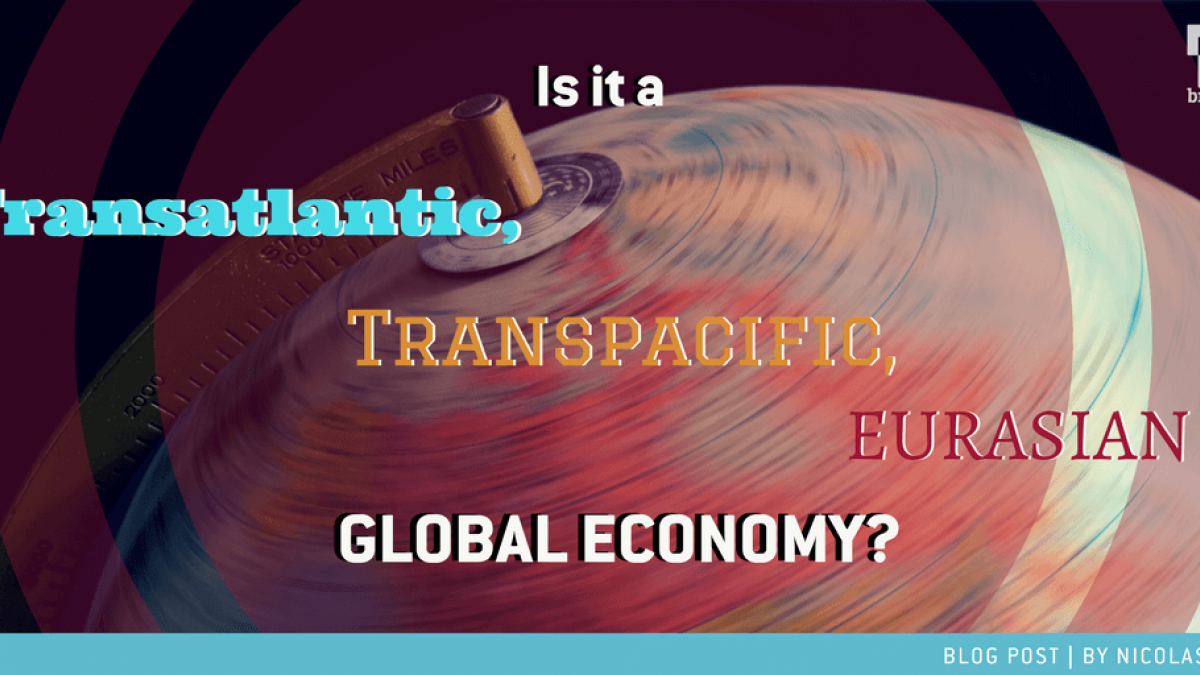Is it a Transatlantic, Transpacific or Eurasian global economy?
A look at the data on bilateral trade, services, investment and protectionism between Asia, Europe and the US in recent years gives some indication of

As the US trade policy has changed with the new administration, many now consider that the EU and Asia have to step up as champions of globalisation. However, Eurasian economic relations have already been more intense than each side’s relations with the US in some dimensions. In this post we look at the data on bilateral trade, services, investment and protectionism between Asia, Europe and the US in recent years.
The chart below shows the evolution of trade volume in recent years – the sum of exports of goods in both directions. EU-Asia trade in goods is by far the most important, peaking at $1.8tn in 2013, consistently more than double the Transatlantic trade. Even looking at the more narrow EU-China trade shows that this trade relation is already bigger than US-China trade.
To Asia, the EU is a greater export destination than the US and likewise, to the EU, Asia is a greater export destination than the US, as shown below. This means the Eurasian trade relation is more important to both partners than their relation with the US.
Another facet of trade is services. The chart below shows the Transatlantic relation is the most important one with regards to trade in services, with a peak at $500bn-worth of services exchanged in 2014.
The Transpacific and Eurasian services relations have experienced moderate growth over the past six years, reaching $299bn and $321bn in 2015 respectively. The Eurasian trade in services is slightly higher than the Transpacific one, although the gap has narrowed.
As can be seen in the chart below, the Transatlantic foreign direct investment (FDI) relations are also far deeper than the other relations. In fact, these strong relations have resulted in deeply intertwined investment stocks across the Atlantic, with $5.8tn-worth of bilateral FDI in 2015. Nevertheless, the Eurasian relation was already deeper than the Transpacific one back in 2009, with $1.1tn- vs $0.8tn-worth of disclosed bilateral FDI.
This gap has persisted over time: in 2015 the Eurasian figure was $1.6tn against $1.3tn for the Transpacific disclosed FDI. We see that Europe is the main investor abroad among the three regions: in 2015, Europe owned $1.2tn-worth of investment in Asia and $2.9tn-worth of investment in the US.
So far we have looked at the exchanges between the US, Europe and Asia. What about policies? The chart below presents information on how trade policies affect the three intercontinental relations we consider. It leverages the Centre for Economic Policy Research’s database on trade policy.
Specifically, the database records every protectionist announcement made by one partner that concerns products currently imported from the other partner. For example, in 2015 the US made 96 protectionist announcements affecting its imports from the EU and the EU made 53 protectionist announcements affecting its imports from the US. We then compute the sum of these two numbers (149) as an indicator of how friendly the EU and US trade policies were towards each other in 2015.
As we can see, Eurasian and Transpacific policies are still much less friendly than Transatlantic policy, with almost twice as many protectionist announcements. Though the gap has narrowed, the Eurasian relation seems slightly less developed than the Transpacific one in terms of trade policy. All three trade relations have seen an increase in protectionist announcements impeding their mutual exchanges since 2012.
The data presented in this post shows that in many aspects, the Eurasian relation is already running deep and, for trade in goods, deeper than their Transpacific and Transatlantic counterparts. For FDI and services, we see that the Eurasian relation is already slightly deeper than the Transpacific one. Nevertheless, in terms of trade policy, the Transpacific relation has been friendlier than the Eurasian one since 2009.
With the current US administration, the One Belt One Road initiative and the trade agreements the EU and some Asian countries currently negotiate, the Eurasian relation might develop further. Rather than a Transpacific one, we are already well on our way towards a Eurasian century.



